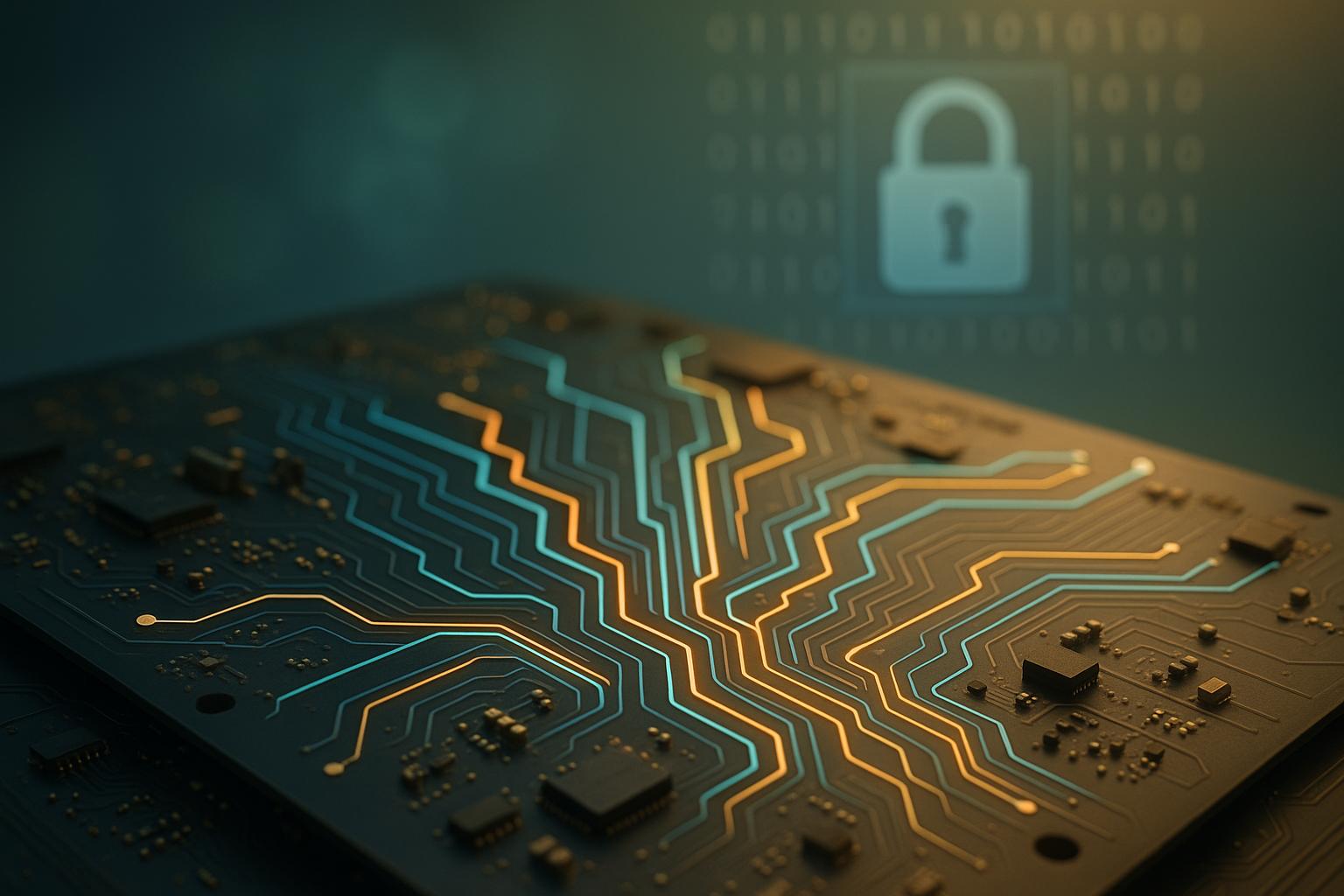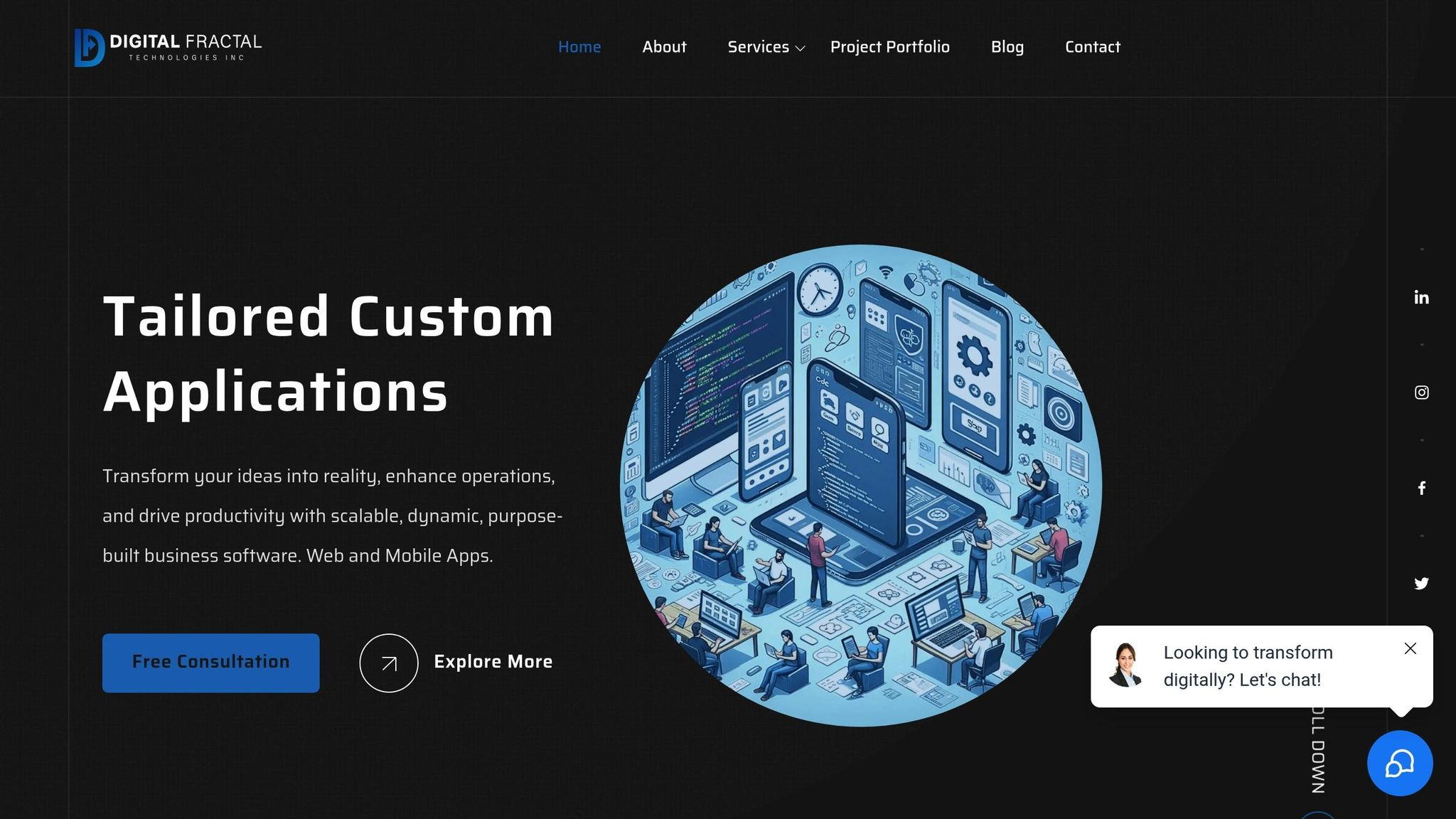
Machine Learning Models for Zero-Day Detection
Zero-day vulnerabilities are security flaws exploited before a fix is available, posing major risks like data breaches and financial losses. Traditional detection methods, which rely on known patterns, fail to address these threats effectively. Machine learning (ML) offers a better solution by identifying unusual behaviours in real-time, even for unknown vulnerabilities.
Key ML approaches include:
- Supervised Learning: Uses labelled data to classify threats but struggles with entirely new attacks.
- Unsupervised Learning: Detects anomalies without labelled data but often generates false positives.
- Deep Learning: Processes complex datasets for high accuracy but demands significant resources.
- Reinforcement Learning: Learns dynamically from feedback but requires extensive training.
While ML significantly improves zero-day detection rates (up to 95% in some cases), challenges like high computational needs, false positives, and lack of transparency remain. Emerging trends like federated learning, explainable AI, and quantum computing aim to address these issues, promising better privacy, transparency, and speed.
For Canadian organizations, adopting ML for zero-day detection requires compliance with privacy laws like PIPEDA and tailored solutions for specific industries. Companies like Digital Fractal Technologies Inc specialize in integrating ML into existing workflows while ensuring data security and regulatory compliance.
Detecting Zero-Day Attacks with AI 🔒
Machine Learning Models for Zero-Day Detection
In the ever-evolving landscape of cybersecurity, machine learning models have become essential tools for tackling zero-day vulnerabilities. These models leverage advanced algorithms to identify and mitigate threats that traditional systems might miss. Each type of model brings its own strengths to the table, allowing organisations to craft tailored solutions for their unique security challenges.
Supervised Learning Models
Supervised learning models are a cornerstone of zero-day detection systems. They rely on labelled datasets containing examples of both benign and malicious activity to train the model. By learning from these patterns, supervised models can effectively classify threats. Their success, however, hinges on the quality and diversity of the training data. If the data is comprehensive, these models can deliver highly accurate results. But without robust datasets, their ability to detect unknown threats diminishes.
Unsupervised Learning Models
Unsupervised learning models take a different route by analysing unlabelled data to uncover anomalies that might signal zero-day threats. These models establish a baseline of normal behaviour and identify deviations that could indicate malicious activity. Techniques like k-means and DBSCAN are often used in network traffic analysis to group similar data points. For example, an unexpected spike in network communications could flag a potential threat. While unsupervised models excel at identifying new and unknown threats, they tend to produce more false positives, requiring human intervention to verify the findings.
Deep Learning and Neural Networks
Deep learning models are at the forefront of zero-day detection, employing neural networks to identify intricate patterns in vast datasets. Convolutional Neural Networks (CNNs) and Recurrent Neural Networks (RNNs) are particularly effective for analysing complex data like network logs, file structures, and sequential attack patterns. Research shows that some deep learning models can achieve detection accuracies exceeding 90% in controlled environments when identifying previously unknown malware samples. For instance, the WavePCA-Autoencoder has shown promise in probabilistic zero-day detection by automatically extracting features from raw data. This enables the detection of subtle indicators, such as unusual system call sequences or hidden malicious code. However, the sophistication of these models demands significant computational resources and carries the risk of overfitting, which can reduce their effectiveness in real-world scenarios.
Reinforcement Learning for Threat Detection
Reinforcement learning takes a dynamic, trial-and-error approach to zero-day detection. These models train agents to make optimal security decisions by learning from continuous feedback. For example, Deep Q-Networks (DQN) can classify data as malicious or benign without prior knowledge of specific vulnerabilities. Over time, these agents refine their strategies, improving both detection accuracy and efficiency. One of the standout features of reinforcement learning is its ability to adapt in real time. As attackers develop new tactics, these models evolve their defences based on prior outcomes, creating a highly adaptive and responsive security system.
| Model Type | Strengths | Limitations |
|---|---|---|
| Supervised Learning | High accuracy for known threats; fast response | Requires labelled data; struggles with unknown threats |
| Unsupervised Learning | Detects unknown threats without labelled data | Prone to false positives; needs baseline establishment |
| Deep Learning | Handles complex, large datasets; automatic feature extraction | Computationally demanding; risk of overfitting |
| Reinforcement Learning | Real-time adaptability; learns from experience | Requires extensive training; complex to implement |
Model Accuracy and Limitations Comparison
When evaluating zero-day machine learning (ML) models, several key metrics come into play: detection rate, false positive rate, precision, recall, and F1-score. These metrics help assess how well a model identifies threats. For example, the detection rate reflects how many actual zero-day attacks the model correctly flags, while the false positive rate shows how often harmless actions are mistakenly identified as threats.
Deep learning models tend to perform well, achieving detection rates between 90% and 95%. One standout, the WavePCA-Autoencoder, has shown F1-scores above 0.90 for detecting zero-day exploits, proving its effectiveness at spotting new malware strains.
Supervised learning models typically achieve detection rates of 85-92%, provided they are trained with broad datasets. However, their accuracy drops when dealing with entirely new attack methods not represented in the training data. On the other hand, unsupervised learning models offer 80-90% accuracy, excelling at spotting unknown threats through anomaly detection techniques.
Reinforcement learning models, such as Deep Q-Networks, demonstrate 88-94% detection rates and improve over time by learning from each encounter. These systems adapt continuously, enhancing their ability to differentiate normal system behaviour from potential threats.
While these metrics highlight the strengths of each model type, they also reveal specific challenges that must be addressed for effective deployment.
Model Limitations and Challenges
Each type of ML model comes with its own set of hurdles. For example, unsupervised models often produce false positive rates of 15-20% in noisy environments. This can overwhelm security teams with excessive alerts, leading to "alert fatigue."
Supervised learning models face the critical challenge of requiring large, labelled datasets. Without a diverse training set that includes multiple attack patterns, these models struggle to handle new threats. Additionally, creating such datasets demands significant time and expertise, limiting their ability to adapt to rapidly evolving attack methods.
Deep learning systems require considerable computational resources, making them less practical for organizations with limited hardware. Another issue is their lack of explainability – security teams often find it difficult to understand why the model flagged a specific activity, complicating incident response and forensic investigations.
Unsupervised learning models also encounter interpretability issues and are highly sensitive to noisy data. Although they excel at identifying anomalies, distinguishing between harmless unusual behaviour and actual malicious activity remains a challenge. Lastly, reinforcement learning models require extensive training and complex implementation, which can be a barrier for organizations needing quick deployment.
ML Model Comparison Table
The table below summarizes key performance metrics and the limitations of each model type:
| Model Type | Detection Rate | Computational Requirements | Primary Limitations |
|---|---|---|---|
| Supervised Learning | 85-92% | Moderate | Needs labelled data; struggles with novel attacks |
| Unsupervised Learning | 80-90% | Moderate to High | High false positives (15-20%); noise sensitivity |
| Deep Learning | 90-95% | High | Lack of explainability |
| Reinforcement Learning | 88-94% | Very High | Complex setup; long training periods |
While deep learning models achieve the highest detection rates, their significant computational demands can be a drawback. Choosing the right model depends on balancing accuracy requirements with available resources and operational needs. Often, combining multiple approaches – such as ensemble methods – can provide a more comprehensive and reliable solution by leveraging the strengths of different models.
For Canadian organizations exploring ML-based solutions for zero-day detection, it’s essential to consider infrastructure capabilities, regulatory requirements, and the specific threat landscape. Collaborating with AI consulting experts can help develop tailored solutions that meet compliance standards while effectively addressing security needs.
sbb-itb-fd1fcab
Future Trends in AI-Driven Zero-Day Detection
AI-driven zero-day detection is shifting gears quickly, with new approaches focusing on improving privacy, collaboration, and speed.
Federated Learning and Collaborative Security
As machine learning (ML) models get smarter, collaborative methods are boosting their effectiveness. Federated learning is one such technique, allowing organizations to train ML models together without sharing sensitive data. Instead of moving data to a central location, it stays local, with processing done in a decentralized way. This not only strengthens privacy but also helps Canadian organizations meet strict data sovereignty rules. That said, federated learning isn’t without its issues – things like inconsistent model performance due to varying data quality and network conditions can be hurdles. Even so, it holds a lot of potential for secure, collective threat intelligence sharing.
Explainable AI for Better Transparency
One of the biggest drawbacks of many deep learning models in cybersecurity is their "black box" nature – it’s hard to understand how they make decisions. Explainable AI (XAI) tackles this problem by offering clear insights into how these models work. This added transparency helps build trust, refine models by spotting biases, and ensures they align with regulatory requirements. For industries like finance and healthcare, where strict oversight is the norm, XAI can be a game-changer for meeting compliance standards.
These advancements in making AI more transparent open the door to even more sophisticated computational methods.
Quantum Computing Impact on Zero-Day Detection
Quantum computing has the potential to shake up zero-day detection by processing data at lightning speed. Its ability to handle complex computational challenges could make identifying patterns in massive datasets much faster – a crucial advantage for real-time threat detection. However, adopting quantum computing isn’t straightforward. It comes with its own set of challenges, like the need for specialized hardware, issues with quantum noise, and difficulties in integration. As the technology evolves, hybrid systems combining traditional machine learning with quantum computing might offer unmatched speed and efficiency in spotting zero-day vulnerabilities.
Using ML-Based Zero-Day Detection in Custom Software Security
Integrating machine learning (ML) into custom software security requires navigating industry-specific risks, technical challenges, and strict compliance requirements. With a 30% increase in zero-day exploits predicted to target sectors like energy and the public sector between 2024 and 2025, the urgency to adopt AI-driven security solutions has grown. This shift highlights the importance of crafting solutions tailored to the unique needs of each industry.
Industry-Specific Security Solutions
Different industries face distinct security challenges, making it essential to adapt ML models to their unique requirements.
In the public sector, stringent data residency rules and auditability standards shape how ML models are deployed. Government organisations must adhere to Canadian privacy laws while ensuring transparency in how decisions are made by these systems.
The energy sector prioritises operational continuity and the ability to detect anomalies quickly. For example, ML models monitoring SCADA systems have proven effective at identifying previously unknown attack methods by flagging unusual commands that deviate from normal operational patterns. These systems are designed to minimise false positives, which could otherwise disrupt critical infrastructure.
Construction companies, on the other hand, need solutions that protect sensitive project data and monitor complex supply chains. ML models in this sector are often used to detect unusual access patterns or attempts to exfiltrate data.
Each industry demands a tailored approach to security that aligns with its specific compliance standards, operational needs, and threat priorities. For instance, while the public sector may focus on strict data sovereignty, the energy sector places greater emphasis on real-time threat detection that doesn’t interfere with daily operations.
Implementation Best Practices
Deploying ML-based zero-day detection successfully begins with high-quality, anonymised datasets. These datasets should include features such as system call patterns, network traffic metrics, and user behaviour indicators to help the models identify subtle anomalies. All data must comply with Canadian privacy laws, including PIPEDA, while retaining the integrity needed for effective training.
The choice of ML model depends on the nature of the threat landscape and the availability of data:
- Supervised learning models are ideal when labelled datasets are available.
- Unsupervised learning models excel in identifying unknown threats without needing pre-classified examples.
- Reinforcement learning, such as Deep Q-Networks (DQN), is particularly useful for real-time detection as it continuously learns from new data.
Key considerations for deployment include managing computational demands, setting up feedback loops for ongoing model improvement, and incorporating explainable AI features to meet regulatory requirements. Starting with pilot programs in controlled environments allows organisations to fine-tune their systems before scaling them up to full production.
To maintain effectiveness, continuous monitoring is critical. It helps reduce false positives, preventing alert fatigue and ensuring the system remains reliable. Combining ML-based detection with traditional security measures and human expertise creates a multi-layered defence that strengthens protection while minimising disruptions.
Digital Fractal Technologies Inc Custom Security Solutions

Digital Fractal Technologies Inc leverages its expertise in AI and custom software to integrate ML-based zero-day detection into existing workflows. Their approach prioritises accountability and data sovereignty – key concerns for Canadian organisations navigating complex regulatory landscapes.
With experience in the public sector, energy, and construction industries, the company specialises in addressing stringent security and compliance demands. Their team combines expertise in data engineering, machine learning, and computer vision to develop solutions tailored to specific industry threats.
Digital Fractal focuses on custom data integration and workflow automation, seamlessly embedding ML-based detection into clients’ business processes. Instead of relying on one-size-fits-all solutions, they work closely with organisations to understand their unique security needs and create targeted applications that enhance both security and operational efficiency.
Their methodology also includes establishing strong policies and frameworks for AI use. By addressing ethical considerations, data privacy, and security protocols from the start, they ensure that ML-based systems not only detect threats effectively but also meet compliance standards.
The company’s track record shows their ability to deliver scalable solutions that adapt to evolving threats. Their commitment to ongoing support and maintenance ensures that ML models remain effective over time, providing long-term value well beyond the initial implementation.
Conclusion
Machine learning is revolutionizing zero-day detection by spotting behavioural anomalies and uncovering patterns that traditional methods might miss entirely.
Studies show that various approaches – supervised, unsupervised, deep learning, and reinforcement learning – bring distinct advantages to the table when it comes to identifying zero-day vulnerabilities. The ability to process massive datasets in real time gives these models a clear edge over conventional techniques.
However, challenges remain. Issues like high false positive rates, susceptibility to adversarial attacks, and significant computational demands still need to be addressed. On the horizon, advancements such as federated learning, explainable AI, and quantum computing hold the potential to push threat detection capabilities even further.
For Canadian organisations, adopting machine learning for zero-day detection must go hand in hand with compliance to local privacy laws and regulations. With critical sectors like energy and public services facing ever-evolving threats, implementing advanced machine learning solutions isn’t just an option – it’s a necessity.
FAQs
What is the difference between supervised and unsupervised machine learning models in detecting zero-day vulnerabilities?
Supervised machine learning models work by using labelled data to recognize and categorize threats. These models are trained with examples of known vulnerabilities and malicious activities, allowing them to spot similar patterns in fresh data. While they excel at identifying familiar threats, they might falter when faced with entirely new or unknown risks.
On the other hand, unsupervised models take a different approach. They don’t rely on labelled data but instead sift through information to detect anomalies or unusual patterns that might signal zero-day vulnerabilities. This makes them particularly adept at spotting threats that haven’t been encountered before. However, the trade-off is that they tend to produce more false positives compared to their supervised counterparts.
When combined with expert analysis, machine learning approaches can greatly improve the detection of zero-day vulnerabilities. This partnership boosts both the efficiency and precision of identifying potential threats, offering a stronger line of defence.
What challenges do organizations face when using deep learning models for zero-day vulnerability detection, and how can they overcome them?
Implementing deep learning models to detect zero-day vulnerabilities comes with its fair share of hurdles. One of the biggest is the lack of labelled data for training. By definition, zero-day vulnerabilities are brand new and unknown, making it hard to gather the data needed to train a model. To work around this, organizations can explore methods like unsupervised learning or creating synthetic datasets to boost model performance.
Another major obstacle is the high computational demand involved in training and deploying these models. Tackling this requires investing in scalable infrastructure and focusing on model optimisation to make processes more efficient. On top of that, there’s the issue of false positives – alerts that don’t point to real threats. These can drain resources and create unnecessary noise. Regularly fine-tuning models and bringing in domain experts during the training phase can go a long way in reducing these errors.
By addressing these challenges head-on, organizations can build more accurate and reliable zero-day detection systems, strengthening their overall cybersecurity defences.
How can Canadian businesses comply with privacy laws when using machine learning for zero-day detection?
To meet the requirements of Canada’s privacy laws, including the Personal Information Protection and Electronic Documents Act (PIPEDA), businesses need to ensure their machine learning tools for zero-day detection prioritize privacy. This means gathering only the data that’s absolutely necessary, anonymizing any sensitive information, and putting strong security measures in place to guard against breaches.
Working with specialists in AI and software development, such as Digital Fractal Technologies Inc., can assist organizations in building solutions that adhere to both legal and ethical guidelines. Their customized strategies help Canadian businesses stay compliant while ensuring effective and efficient vulnerability detection.

